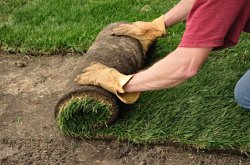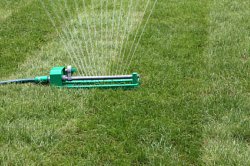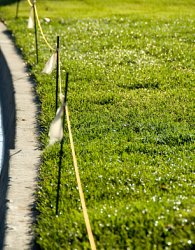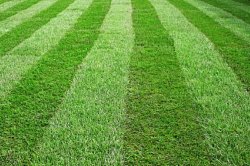Proper sod care after it has been installed is very important. A lawn that has been sodded correctly looks really nice once established. It is critical to water immediately and avoid walking on it or mowing until it is firmly rooted.

Sod that has just been laid needs to be watered within 30 minutes. Then keep it moist with daily watering until it has firmly rooted. Check the moisture by lifting corners of sod and looking under it – the soil should be moist but not mucky.
After the first week, you can start to back off from daily watering. Just keep an eye on the weather and the new grass – keeping it moist.

Keep off the grass for the first month! Prevent unnecessary traffic and use until it is established. Roping off the new sod – or putting up signs – can help direct traffic away from the area.
Try to avoid heavy use for several months – it can take up to a year for a new lawn to fully establish.

It should be ready to mow in 2 to 3 weeks. It’s okay – and actually good – to let it grow a little longer. Just don’t cut off too much all at once.
Stop watering a couple of days before mowing to let it firm up. If it’s too wet you risk creating ruts or pulling up new sod.
Walk the lawn, gently tug on a few pieces of sod to check for rooting and look for soft, wet spots to avoid. It will be ready to mow if it is firmly rooted.
Set the mower high for the first couple of cuttings, gradually lowering the cutting height over successive mowings.
Keep your new lawn looking good with these mowing tips.

What we cover
ToggleLong-Term Sod Care
The new grass will benefit from a light fertilizer application 4 to 6 weeks after it has been planted. Use a slow-release or organic fertilizer.
Avoid using herbicides (weed killers) the first year. This includes crabgrass preventers (pre-emergence).
Soil layers can inhibit water infiltration. Core aeration within the first year with help breaks up any soil layers created by the different mediums that the sod was grown on.
You might like these lawn care tips
How to choose the best lawn fertilizer. What do the numbers on the bag mean? Are organic fertilizers more eco-friendly than chemicals? Consider costs and nutrient needs. Are they pet-safe?
Lawn Mowing: Tips and techniques, the basics of lawn care. How to cut grass like a pro. Cutting grass to keep it looking groomed and healthy. DIY tips and advice for growing grass.
Use this fertilizer calculator to determine the amount of granular fertilizer product that is needed to spread on your lawn according to recommended rates.
